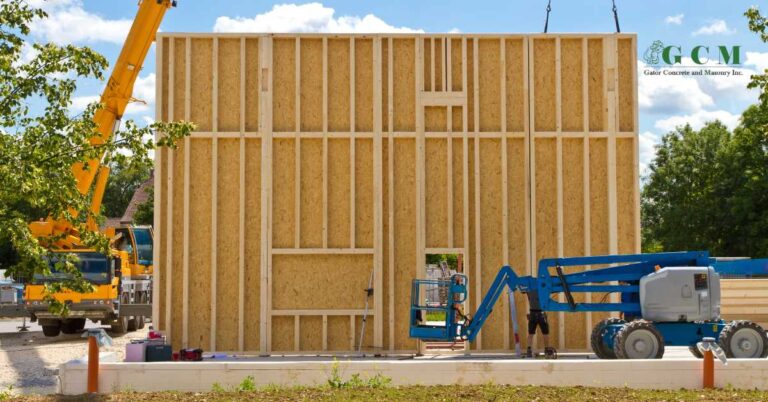One of the construction methodologies that is becoming increasingly popular is called prefabricated construction. Also known as prefab construction, it involves creating some parts of the building offsite and putting them together on the job site. Parts of the building are made offsite in a factory, then brought to the construction site and assembled.
There are several different types of famous prefabs, each with its benefits. In this article, we have compiled a comprehensive list of the various types of prefabs and their pros and cons. But first, let us define prefabricated construction further.
What is Prefabricated Construction?
Prefabricated construction is a method that involves making parts of the building in a controlled setting that is away from the construction site and then bringing the parts to the site and putting them together there.
Prefabricated construction has been around for a long time because it is an integral part of the planning of building projects. There are several reasons why prefabricated construction is becoming more popular in the modern building business:
- Saves time and money compared to regular buildings
- Easier to monitor quality
- Long-lasting and environmentally friendly
- It helps speed up the construction process
In the following sections, let us look at the pros and cons of using prefabricated construction.
The Benefits of Using Prefabricated Construction
Prefabricated construction has become increasingly popular because it has many benefits, such as lower costs, better quality control, and long-term use. Let us look at how it can help you in your next project.
Cost Savings
Prefabricated construction can help you save a lot of money compared to regular buildings. This is because you are making the building parts away from the construction site, so it can cut down on work costs and speed up the building process. You can be sure of the quality of the parts before they are installed onsite. It cuts down on waste and uses raw materials better, which can save money in the long run.
Lower Labor Costs
Using prefabricated buildings saves a lot of money on labor costs. Since less work needs to be done on the construction site, the cost of workers will go down. The construction process will be much more efficient since the parts are made away from it.
Faster Construction Times
Prefabricated construction also speeds up the building process as putting the materials together onsite is much easier. This means that building projects can be finished faster, which cuts down on the time and money needed for building.
Less Waste Production
Another benefit of prefabricated buildings is that it cuts down on waste. There is less trash on the construction site because the building parts are made elsewhere. In addition, making good use of materials during the manufacturing process leads to less waste and lower building costs.
Quality Checking
Prefabricated buildings make it easier to monitor quality and ensure consistency in production. Because the building parts are made in a controlled environment, prefabricated construction provides better quality control. The factory-controlled manufacturing method ensures that the building parts are made exactly as planned and of the highest quality possible.
Job Safety
Ensuring job safety is also better with prefabricated construction, which makes the building process safer. The building parts are made away from the construction site, which lowers the risk of crashes and injuries.
Less Damage to The Environment
As mentioned, prefabricated construction creates less waste since materials are used more efficiently during the production process. A smaller carbon footprint is also created when natural resources and energy are used less.
Good Use of Resources
The controlled manufacturing process in the factory ensures that materials are used effectively, which means there is less waste and a lower total cost.
Energy Efficiency
Another benefit of prefabricated buildings is that it saves energy. The building parts are made away from the site using efficient materials and methods. This makes the building structure use less energy and have less of an effect on the world.
The Different Types of Prefabricated Construction
Now that we have discussed the benefits of using prefabricated construction let us learn about the different types. Depending on your project’s specific requirements, you can choose either of the options below.
Modular Construction
Modular construction is one of the standard types of prefabricated construction. It means making buildings offsite by putting together separate parts, or modules, that will be put together on the construction site to create a whole building. This cuts down on work that needs to be done onsite and speeds up the building process. Apartments, schools, companies, hotels, hospitals, and stores are all types of modular buildings.
Panelized Construction
Panelized construction means putting together the building onsite from wall and roof pieces that were made ahead of time. The panels are made in a workshop and then brought to the building site. Residential homes, business buildings, and warehouses are all examples of panelized buildings.
Pre-cut Construction
Pre-cut construction is a type of prefabricated construction in which building parts are created and cut in a workshop and then brought to the job site. Then, these parts are put together onsite. Pre-cut building has benefits like less work to do onsite, better quality, and less waste.
Panelized Wood Framing
These systems consist of extended frames made from laminated wood covered with plywood or a roof deck. These prefabricated products are mainly used to build roofs. Sandwich panels are made up of an insulating core and two thin layers of different materials that are stuck together tightly on both sides.
Uses of Prefabricated Construction
Prefabricated construction can be used in various industries. The construction industry involves a million moving parts, so building them offsite can help ensure its quality and timely construction. In this section, we will look at how prefabricated construction can be used in residential, business, and industrial buildings.
Modular Homes
Modular homes are residential buildings made from parts that have already been made. Modular houses are known for being quick to build, affordable, and environmentally friendly. They are often customized to fit the needs of the people who live in them.
Manufactured houses
These are flat-pack houses that are made in a factory and then brought to the site in pieces. They are made to be put on a permanent base, and they’re a quick and cheap way to build a house. Prefabricated materials, like roof trusses and outer walls, are often used to make manufactured homes. These materials help speed up the building process.
Prefab Homes
Prefab Homes are made up of premade parts that are put together onsite. The goal of prefabricated homes is to be affordable, energy-efficient, and good for the earth.
Green Buildings
These are buildings made with environmentally friendly products and methods. One environmentally friendly and long-lasting way to build green homes is with prefabricated construction. This method helps cut down on trash, save energy, and reduce the building’s carbon footprint.
Offsite Construction
In offsite construction, building parts are made in a factory or other manufacturing plant ahead of time and then transported to the construction site. This method is often used to create significant buildings like factories, warehouses, and distribution centers in the business sector.
Challenges in Using Prefabricated Construction
All construction systems have their pros and cons. Now that we have established all the benefits and their uses, we have listed here some of the challenges you may encounter when using prefabricated construction.
Few Changes Can Be Made
One of the biggest problems with prefabricated buildings is that they are inflexible. Since they are made away from the site where they will be used, they are generally made to standard sizes and requirements. This might not be ideal for projects that need particular patterns or materials that are not commonly used.
Logistics and Transportation
Logistics and transportation are also significant problems in prefabricated buildings. Modules and parts that have already been made have to be moved from the factory to the construction site, which can be expensive and complicated. Onsite storage may also be required, which can raise the overall cost of building.
Thoughts and Preferences
Negative ideas and biases are other problems with prefabricated buildings. In the past, buildings built with prefabricated parts were thought to be of lower quality, cost less, and last less long. However, as technology and building methods have improved, prefabricated construction has become more complex. It could be used to make high-quality, long-lasting buildings that are good for the environment.
Key Takeaway
Prefabricated construction is becoming more common worldwide, and this trend is likely to continue. With fast progress in technology, the future of prefabricated buildings looks bright. New tools like 3D printing, robots, and automation make more accurate and quicker production of complex building parts possible. Adding smart homes and building technologies to modular buildings is another exciting thing about the future of this type of construction.
Prefabricated buildings offer many benefits, such as shorter construction times, better quality control, and lower costs. To stay competitive and take advantage of the benefits of modular construction, people who work in the construction business need to keep informed and up to date on these changes.

